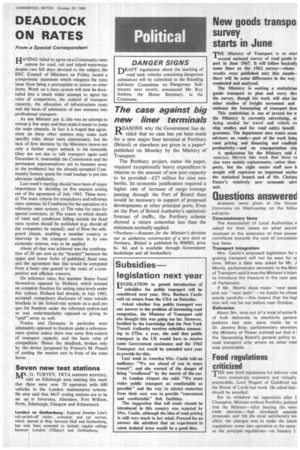DEADLOCK 07 RATES
Page 29

If you've noticed an error in this article please click here to report it so we can fix it.
From a Special Correspondent
HAVING failed to agree on a Community rates
system for road, rail and inland waterways despite two full days devoted to the subject, the EEC Council of Ministers on Friday issued a compromise statement which relegates the rates issue from being a prerequisite to action on other items. Work on a rates system will now be dovetailed into a much wider attempt to agree the i
rules c f competition, the control of transport capacit, , the allocation of infrastructure costs and the basis of admission of new entrants into professional transport.
As one Minister put it, this was an attempt to retreat a few steps and thus make it easier to jump the main obstacle. In fact it is hoped that agreement tin these other matters may make such specifi rules about rates unnecessary, but the lack oil firm decision by the Ministers means not only a further major setback to the timetable (they are not due to talk transport again until December 6; meanwhile the Commission and the permanent representatives are to hammer away at the problems) but the already-accepted Community l licence quota for road haulage is put into abeyanCe indefinitely.
Last week's meeting should have been of major importance in deciding on five matters arising out of the agreement of July 1965. These were: a) The main criteria for compulsory and reference rates systems; b) Conditions for the operation of a reference rates system; c) The rules for rates for special contracts; d) The extent to which details of rates and conditions falling outside the fixed rates system should be published (e.g. should all the companies be named): and e) How the safeguard clause, enabling a member country to intervene in the transport market in its own economic interest, was to be applied.
About all that was achieved was the confirmation of 20 per cent as the "bracket" between the upper and lower forks of published, fixed rates and th agreement that this would be computed from a basic rate geared to the costs of a competitive and efficient concern.
On reference rates, five member States found themselves opposed by Holland, which insisted on complete freedom for setting rates levels under this system. Holland had already, in July 1965, accepted compulsory disclosure of rates outside brackets in the forked-rate system as a quid pro quo for freedom under the reference system and so was understandably opposed to giving its "quid" away as well.
France and Germany in particular were adamantly opposed to freedom under a referencerates system unless there was some firm control of transport capacity and the basic rules of competition. Hence the deadlock, broken only by the device (proposed by France's M. Pisani) of puting the market cart in front of the rates horse.
























































































































